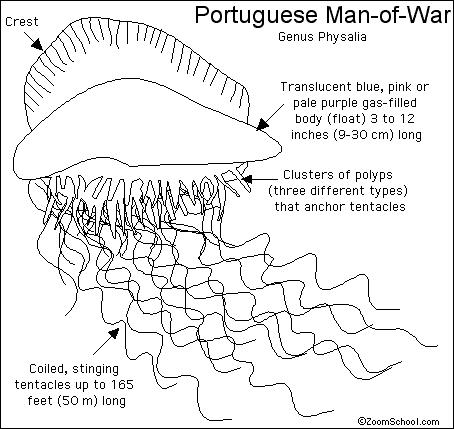
 |
| You might also like: | Jellyfish (Unlabeled) | Cephalopod Printouts | Krill Printout | Sea Anemone Printout | Jellyfish | Today's featured page: Making Change with Dollars - Worksheets |
| Ocean Animal Printouts | Portuguese Man-of-War | Animal Printouts Label Me! Printouts |


A small fish (Nomeus gronovii, 8 cm long) is mostly immune to the Man-of-War's poison and lives protected (from other predators) among the tentacles. This fish eats the tentacles (which are regenerated), but sometimes the fish is eaten by the Man-of-War.
Diet: The Portuguese Man-of-War eats small fish and other small ocean animals that is stings with its long tentacles. The poison in the stingers paralyzes the prey, which the Man-of-War then eats. The poison cannot kill humans, but the sting can be very painful.
Anatomy: The Man-of-War floats on a gas-filled, blue to pink, translucent body called a pneumatophore (belonging to a single animal). The body is 3 to 12 inches (9-30 cm) long. The crest (only a few inches tall) above the float acts like a sail, moving the animal across the seas. Polyps support the tentacles and are located under the float; there are 3 types of polyps: dactylozooid (that find and catch prey with poisonous stingers called nematocysts), gonozooid (that reproduce), and gastrozooid (that digest the food, like a stomach). The coiled, stinging tentacles can be up to 165 feet (50 m) long.
Classification: Phylum Cnidaria (corals, jellyfish, sea anemones, hydrozoans), Class Hydrozoa, Order Siphonophora, Genus Physalia.
| Search the Enchanted Learning website for: |